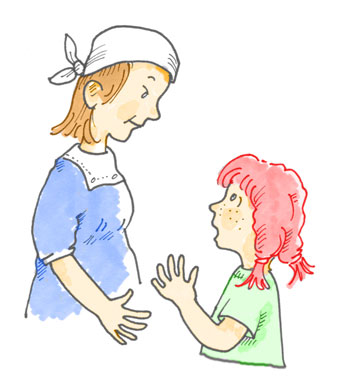
Active (or reflective) listening is an effective tool of communication. One that will serve you well as you parent your child and (sooner than you may think) the adolescent that child will become. Active listening is the art of observing and listening to feelings, then reflecting them back. Active listening does not require that you agree with your child’s feelings, but it allows your child to feel connected and understood—something all people need—and provides an opportunity to explore and clarify those mysterious impulses known as emotions.
Four‐year‐old Chrissy ran through the front door, slamming it so forcefully that the pictures rattled on the wall, and promptly burst into tears. “Tammy took my ball,” she wailed. “I hate her!” Then Chrissy threw herself onto the sofa in a storm of sobs.
Her mom, Diane, looked up from the bills she was paying. Resisting the impulse to scold Chrissy for slamming the door, she said quietly, “You seem pretty angry, kiddo.”
Chrissy pondered for a moment. “Mom,” she said plaintively, sniffling a little, “Tammy is bigger than me. It isn’t fair for her to take away my stuff.”
″It must be pretty frustrating to be picked on by a big girl,” Diane said, still focusing on reflecting her daughter’s feelings. “Yeah. I’m mad,” the little girl said firmly. “I don’t want to play with her anymore.” She sat quietly for a moment, watching as Diane put stamps on envelopes. “Mom, can I go play out in the backyard?” Diane gave her daughter a hug—and a great deal more.
By simply reflecting back her daughter’s underlying feelings (active listening), Diane refrained from lecturing, rescuing, or discounting her daughter’s feelings. She allowed Chrissy the opportunity to explore what was going on for her, and in the process, Chrissy discovered a solution to her own problem. Some other time, Diane might be able to talk with Chrissy about avoiding future problems—and perhaps ask her what she could do to express her anger instead of slamming the door.
Diane also showed respect for her daughter’s feelings. Parents often do not agree with (or completely understand) their children’s emotions, but active listening does not require you to agree or completely understand. It invites children to feel heard and lets them know it’s okay to feel whatever they feel. Validating a child’s feelings with love and understanding opens the door for real connection and problem solving and works toward building a lifelong relationship of love and trust.
Pretend these statements are made by a child. How would you respond?
- ″No! I won’t take a nap!”
- ″I want a bottle like the baby has.”
- ″I hate going to the doctor.”
- ″Nobody will let me play with them.”
Some parents try to argue a child out of her feelings in hopes of changing her mind or helping her feel better. These attempts may sound like this:
- ″Of course you need your nap—you’ve been up since six. When will you learn that you need to rest?”
- ″Don’t be silly. Only babies use bottles. You’re a big boy now.”
- ″I keep telling you, you have to go to the doctor to feel better.”
- ″Why sweetie, you know you have lots of friends. What about . . .”
Each of these examples may leave the child feeling misunderstood and defensive—with the likely result of an argument and frustration for both of you. Active listening might sound like this:
- ″You look disappointed that you have to stop playing with your toys. You were having a lot of fun.”
- ″Sounds like you’re feeling left out in all the fuss over your new baby sister. Is there more you can tell me?”
- ″Sometimes I feel a little afraid of going to the doctor, too.”
- ″You seem pretty sad about being ignored by the older kids.”
These responses make no judgments and open the door for children to go further in exploring their feelings. Asking “Is there more?” indicates a willingness to listen and may help a child discover deeper, buried feelings.
Like most adults, sometimes all children really need is for someone to listen and understand. Active listening will help your child learn about his own feelings (and appropriate ways to express them) and will help you focus on what’s really important.


